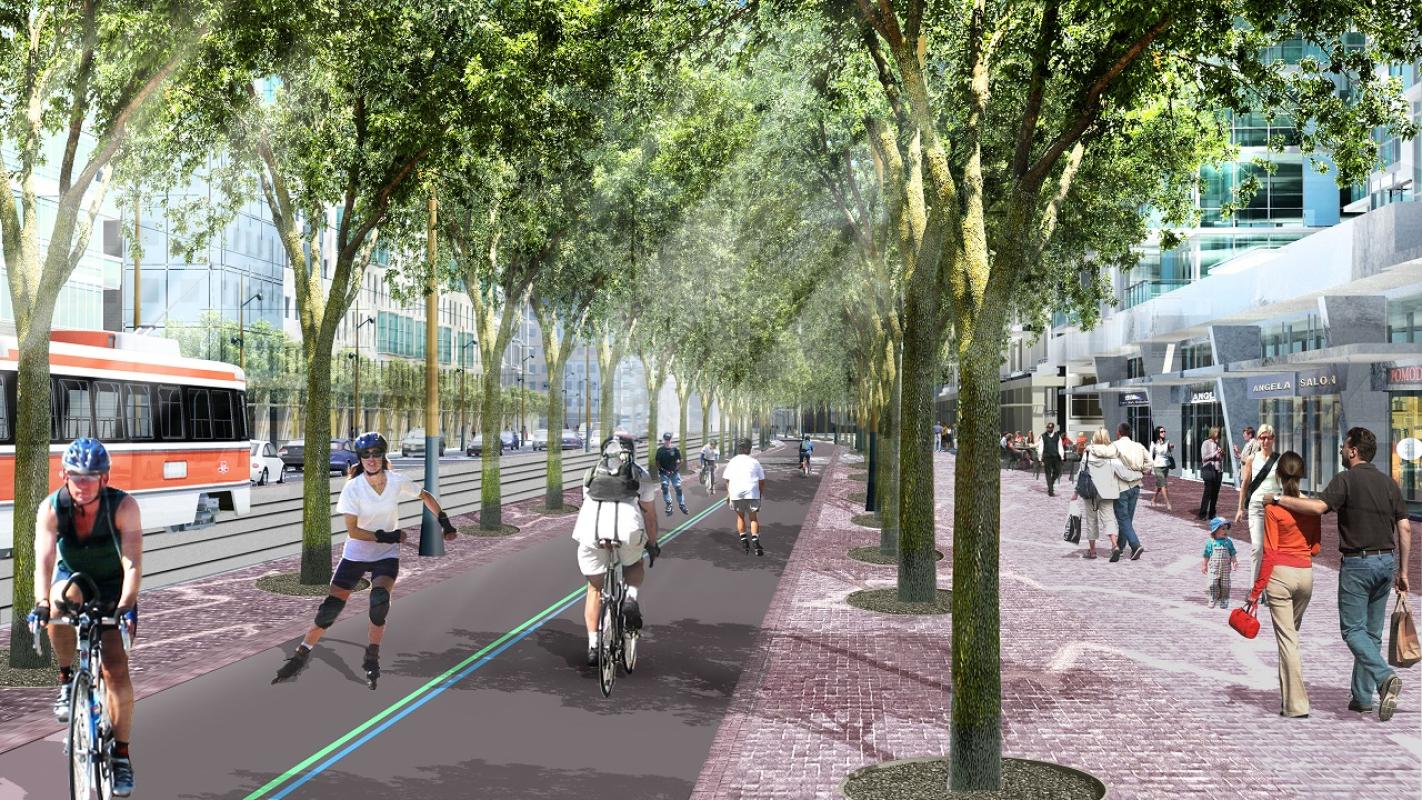Transit Environmental Assessment
Waterfront Toronto together with the TTC and the City of Toronto began an Environmental Assessment (EA) in March 2006 to determine the appropriate transit facilities for East Bayfront and future waterfront communities in the Port Lands. The study, which was designed to analyze the long term residential, employment, tourism and waterfront access needs for the area, began as an Individual EA for the entire eastern waterfront and was converted to a Class EA process specific to East Bayfront transit in October 2007.
At the same time, a companion EA was initiated by Waterfront Toronto and the City of Toronto to revitalize Queens Quay — Toronto’s main waterfront street. The Queens Quay Revitalization EA recommended that the number of lanes of traffic on the street be reduced from four to two. This will provide two lanes of east-west traffic on the north side of the street, transit in the centre and an extended Martin Goodman Trail and pedestrian promenade along the south side.
Environmental Assessment Process
The East Bayfront Transit EA was conducted under Schedule C of the Municipal Class EA process. It followed a formal process which included data collection, the development of a problem statement and the identification and analysis of several different alternative planning solutions and design concepts. The assessment of design alternatives was undertaken jointly by the project proponents. Throughout the process, the potential environmental, social, cultural, and economic impacts and benefits of each alternative were assessed.
Recommended Transit Design
During the East Bayfront Transit EA, the urban design quality of the corridor was considered from the beginning of the process, alongside traffic and transit infrastructure needs.
After a thorough and rigorous analysis which included a robust consultation program with stakeholders, agencies and the public, it was determined that the transit corridor for East Bayfront would run along Queens Quay to Union Station via Bay Street and that Light Rail Transit in its own right of way is the preferred type of transit.
In addition, the EA also looked at where the streetcar would surface to serve the eastern part of Queens Quay. Currently the streetcar runs underground beneath Bay Street and surfaces from a portal on Queens Quay serving the western part of Queens Quay only. The EA recommends that the streetcar portal for East Bayfront should be on Queens Quay just east of Yonge Street.
An interim streetcar loop is planned at Parliament Street in the east end of East Bayfront. The study also provides for a future extension of the LRT line through the Lower Don Lands and the Port Lands as those communities develop.
East Bayfront Transit EA now complete
In July 2010, Waterfront Toronto and The Toronto Transit Commission TTC received a letter from Ontario’s Minister of the Environment John Gerretsen allowing the recommendations from the East Bayfront Transit Environmental Assessment (EA) to proceed. This letter officially ends the East Bayfront Transit EA process.
The Environmental Study Report (ESR) and Appendices are available upon request. The ESR documents the evaluation and decision making process used to reach the recommendations presented in the EA. Please contact us at info@waterfrontoronto.ca if you'd like to receive a copy of the archived documents.
Public Consultation
Public outreach has been an integral part of this study and a critical part of the decision-making process. Over the course of the project, three formal public workshops/information centres and one drop-in centre were held as part of the public input process. A Community Liaison Committee (CLC) was also established to discuss and receive feedback from key stakeholders on a continuous basis. The CLC, which included representatives from a variety of neighbourhood associations and advocacy groups met on seven occasions throughout the process. In addition, a Technical Advisory Committee (TAC) representing a variety of government agencies and city departments provided important feedback during the process.
Public and technical feedback has resulted in conclusions and a refined design concept that addresses the concerns and issues brought forward by the community. Detailed presentations from the Transit EA public meetings, CLC meetings and TAC meetings are available in the document library.

